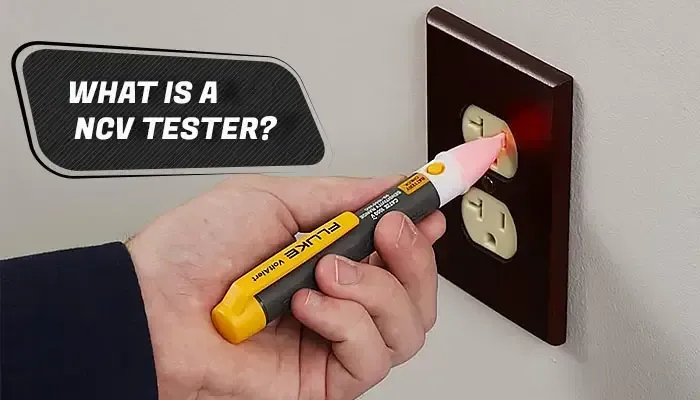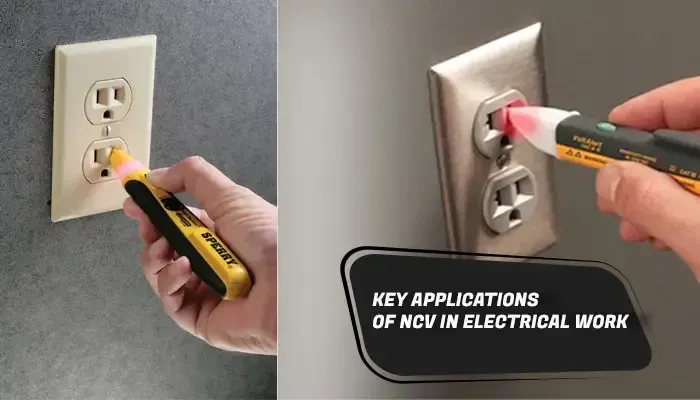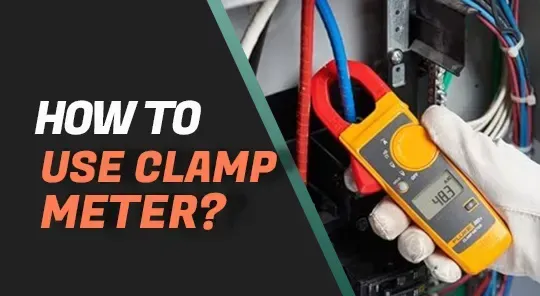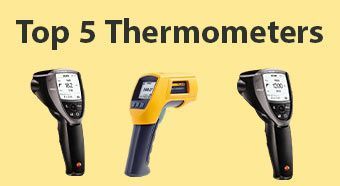What is A Non-Contact Voltage Tester?
In any industry involving electricity, safety should be the main priority. Electricians, technicians, and even DIY enthusiasts are constantly exposed to electrical hazards that could potentially be fatal if proper precautions are not taken. One of the critical safety features incorporated in modern multimeters is the Non-Contact Voltage (NCV) tester. This functionality has not only revolutionized electrical testing but has also improved the safety standards across the board.
But what exactly is an NCV tester, and why should it be a tool of choice for anyone dealing with electrical work? In this article, we’ll explore what an NCV tester is, how it works, and how it is improving the safety. We’ll also look into its various applications, limitations, and tips for its effective use.
What is a NCV Tester?
A Non-Contact Voltage Tester is a feature that recently been added into modern multimeters that allows users to detect the presence of voltage in a circuit without physically touching any of the components. It works by sensing the electric field around the live conductors and providing a signal (visual, audible, or both) to alert the user when voltage is detected. This means you can check if a wire or a terminal is live before you make contact, greatly reducing the risk of electrocution or damaging the equipment.
What makes the NCV feature truly indispensable is the non-intrusive nature of its testing. Traditional methods of voltage testing required physical contact with live parts of the circuit, introducing the risk of electric shock. The NCV function bypasses this need entirely, offering a safe and easy way to check for voltage.

The physics Behind NCV: How Does It Work?
Understanding how an NCV tester works can help users make better use of it. The NCV tester in a multimeter detects AC voltage by utilizing capacitive coupling. When alternating current flows through a wire, it creates an electromagnetic field around it. The NCV sensor in the multimeter is designed to detect this field without direct contact at a safe distance.
Here’s a step-by-step breakdown of the process:
- Detection of Electric Field: Every conductor carrying an AC voltage (and has electrical Flow) produces an electric field. The NCV sensor picks up this electric field when it comes into close proximity to the conductor.
- Signal Conversion: Once the electric field is detected, the multimeter processes this information and generates a readable signal for the user—typically in the form of a beeping sound or flashing light.
- User Feedback: The multimeter uses visual or auditory signals to indicate the presence of voltage. Some advanced models even vibrate to alert the user, making it hard to miss the detection of a live circuit.
Know you know why NCV testers are generally designed for alternating current (AC) detection. They are not as effective with direct current (DC) since DC doesn’t create the alternating electric fields necessary for the capacitive coupling mechanism.
Why is the NCV Feature Critical for Safety?
One might wonder why so much emphasis is placed on NCV technology in multimeters. The answer lies in the sheer improvement it brings to electrical safety. Here’s how:
- Reduced Risk of Electric Shock: Because NCV testing doesn't require direct contact with wires, it virtually eliminates the possibility of electric shock during voltage detection. For electricians who regularly work in high-voltage environments, this can be a life-saving feature.
- Speed and Efficiency: Traditional testing methods require more steps—setting up leads, probing the correct points, etc. With NCV, you can quickly scan an area for live wires, saving time and reducing the complexity of the task.
- Damage Prevention: Some electrical components can be delicate, and physical probing may cause damage. NCV allows testing without disrupting the integrity of the circuit or risking damage to sensitive equipment.
- Multimeter Versatility: Multimeters equipped with NCV allow you to detect live voltage in various settings, from household outlets to industrial systems. The feature works in outlets, wires, junction boxes, and even faulty breakers. This versatility makes NCV testers valuable for a wide range of electrical tasks.
Key Applications of NCV in Electrical Work
The NCV function is invaluable in many real-world scenarios. Here are some of the most common applications:
1. Testing Outlets and Switches
One of the most straightforward uses of an NCV tester is for checking whether an electrical outlet is live. Simply bring the tester near the outlet's prongs or faceplate, and the multimeter will alert you if voltage is present. This is a fast and safe way to determine if an outlet is functioning before attempting repairs or installations.
Switches can also be tested similarly. You can identify whether voltage is reaching the switch without opening it, allowing you to troubleshoot circuits faster.
2. Identifying Live Wires in Junction Boxes
When working with junction boxes, there may be multiple wires bundled together, and not all may be live. The NCV function helps identify which wires are carrying voltage, preventing accidental contact with live wires. This feature is especially useful in complex installations where multiple circuits may converge in one location.
3. Verifying Circuit Breakers
NCV testers can help you determine if a breaker is live before flipping it. Some breakers may appear functional even when they're not supplying voltage properly. With an NCV-enabled multimeter, you can scan breakers quickly and efficiently to ensure they’re delivering power.
4. Locating Faults in Electrical Systems
Faulty wiring is a common issue in both residential and industrial settings. An NCV tester allows you to scan wire runs, outlets, or panels for live circuits without dismantling the entire system. By pinpointing live circuits, you can identify faults more easily and avoid unnecessary repairs.
5. Testing Light Fixtures
Light fixtures can sometimes be tricky to work with. If a fixture isn’t working, you can use an NCV tester to check whether power is reaching the fixture without disassembling it. This saves time, especially when working with complex installations such as recessed lighting or chandelier fixtures.

How to Use an NCV Tester Effectively
To get the most out of the NCV feature, it’s important to follow best practices. Here are some tips to help ensure you’re using the tool safely and effectively:
1. Always Test the Tester
Before trusting your NCV feature on a potentially dangerous circuit, it’s wise to test it on a known live circuit. This ensures that the tester is functioning correctly before relying on it in a critical situation. Many electricians will quickly scan a known live outlet or wire before using the NCV on their actual project.
2. Understand Sensitivity Levels
Different multimeters have varying levels of sensitivity when it comes to their NCV function. Some will detect voltage from a few inches away, while others may need to be in closer proximity. Familiarize yourself with the sensitivity of your device by practicing in controlled environments.
3. Use It as a Preliminary Test
While the NCV feature is incredibly useful, it should often be considered a preliminary test rather than a definitive one. After determining that a circuit is live or dead, follow up with more traditional testing methods like using probes to confirm the exact voltage level if needed. The NCV is great for fast, initial checks, but it should complement other testing methods.
4. Mind the Material of the Wires
In some cases, thick insulation or certain materials may limit the effectiveness of the NCV tester. For instance, wires bundled inside metal conduits can reduce the NCV’s ability to detect voltage. Be cautious when testing such installations, as the results may be inaccurate.
5. Clean and Maintain Your Tool
The sensor on an NCV-enabled multimeter can get dirty over time, which may affect its ability to detect voltage. Regular cleaning of your tool and ensuring it’s properly maintained will help extend its lifespan and maintain its accuracy.
What are the Limitations of NCV Testing?
Despite the significant benefits of NCV testing, it’s important to be aware of its limitations.
- Works Best with AC Voltage: As mentioned earlier, NCV testers are most effective with alternating current (AC) voltage. Direct current (DC) doesn’t produce the same electromagnetic fields, making NCV detection unreliable in DC circuits.
- Limited Range: The NCV feature is designed to detect voltage in close proximity. While some high-end models can detect voltage from a few inches away, most testers need to be relatively close to the wire or outlet. This means it’s not suitable for detecting live circuits behind thick walls or metal barriers.
- False Positives: In some instances, NCV testers may pick up interference or stray electromagnetic fields, leading to false positives. This is especially common in environments with multiple live circuits running parallel to one another. Users need to be aware of these potential false readings and verify results with additional testing if necessary.
The Evolution of NCV Technology
The NCV feature is relatively new in the history of multimeters. However, it has quickly become a standard feature in modern devices, revolutionizing how electricians approach safety and troubleshooting.
Historically, voltage testing was done by physically probing the circuit, a process that inherently carried risks. The development of NCV technology offered a safer, faster, and more efficient way to detect live voltage. Today, leading multimeter manufacturers like Fluke, Hioki, ,Extech and ... have embraced NCV, making it a core feature in their devices.
Some high-end models now offer enhanced NCV functionality, such as adjustable sensitivity levels and multi-signal feedback, allowing users to detect even faint voltage signals with greater precision. As technology continues to evolve , we can expect further advancements in NCV functionality, making electrical work safer and more efficient than ever.
Choosing the Right Multimeter with NCV
If you are looking to buy a multimeter with NCV capabilities, there are several factors to consider. First and foremost, you want to ensure that the multimeter offers reliable NCV functionality. Not all NCV features are created equal, and lower-quality models may not offer the same level of sensitivity or accuracy.
Additionally, consider the overall functionality of the multimeter. Does it offer the other features you need for your work, such as resistance measurement, continuity testing, or current measurement? Many multimeters are designed with a range of functions, allowing them to serve as versatile tools for electricians.
Lastly, durability matters. Look for a multimeter built to withstand the wear and tear of everyday use. A rugged design with proper insulation and a reliable NCV sensor will ensure that your multimeter lasts for years.






